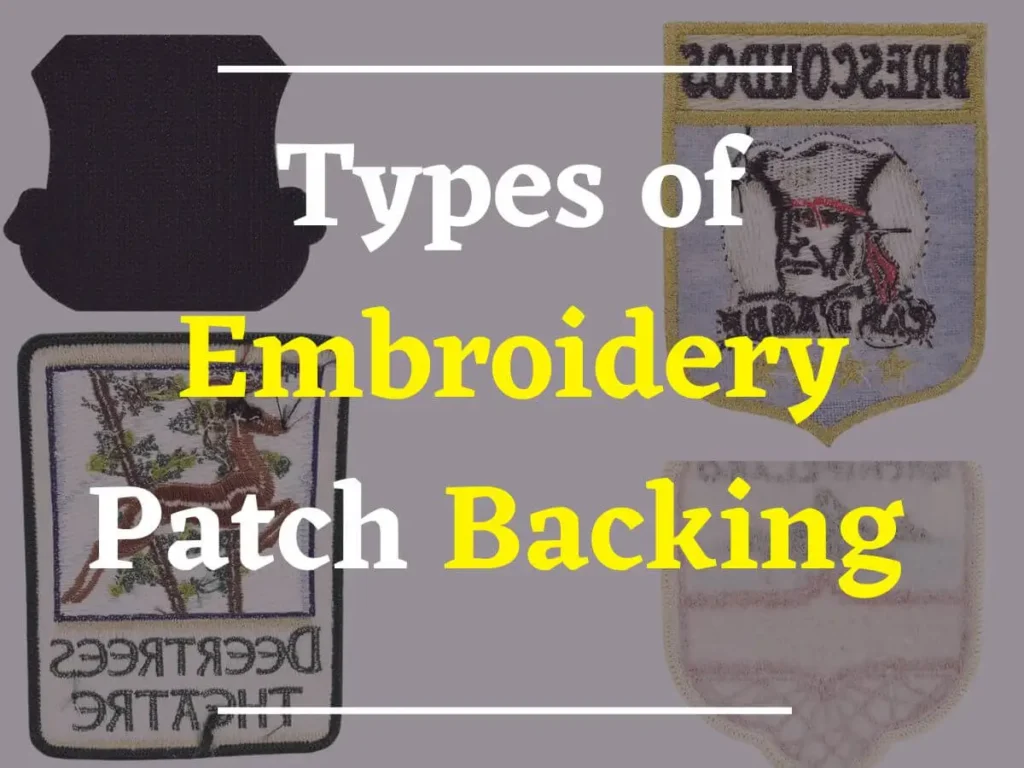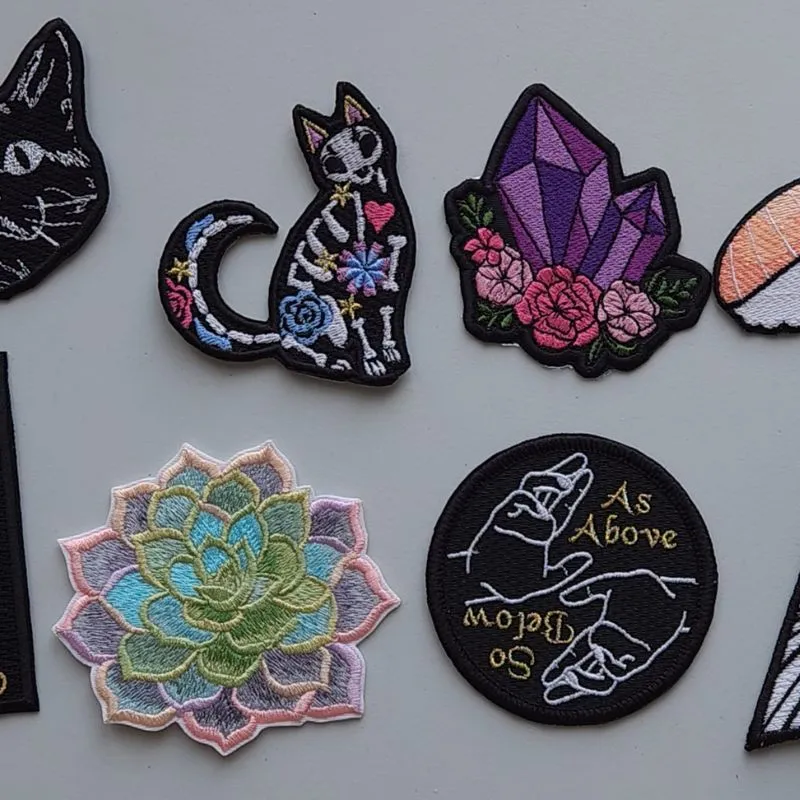
Different types of patch backing are available for custom patches. The type of backing you choose will depend on how and where you plan to use it.
Choosing the right backing type is as important as the design itself. It doesn’t matter whether you are using permanent or flexible patches, the right backing type will ensure the quality and design of the product.
Patches are a great way to add personalized touch to your clothes and accessories. You will choose the backing type depending on your use case and fabric. Every backing type has its own pros and cons. Here are a few different backing types for patches:
10 Different Types of Backing for Patches
1. Sew-On Backing

Sew-on is a permanent, reliable, and more secure method to patch onto the fabric. These patches will last long due to their lightweight For extreme conditions like extreme weather, washes, and contact sports, will not cause any damage to patches.
This method is quite applicable for sewing ideal patches like embroidered, woven, and chenille patches on backpacks, cotton, wool, uniforms, shirts, and jackets. Sewing on heavy fabrics like leather will depend upon the thickness of the fabrics. All it takes is a needle to pass the fabric.
Pros Of Sew-On Backing
- Strong and durable
- Work on any Fabric
Cons Of Sew-On Backing
- Require Sewing Skills
- Time-Consuming to apply
2. Iron-On Backing
Like Sew-On backing Iron-on or heat press is not a permanent solution for patching, but these patches will last for years. it’s the quickest and fastest way to patch on the fabric. The patch back is applied with heat-sensitive glue.
When you apply heat on the patch the glue will melt on the article you are patching on. Once it gets cool the patch will stick on the fabric. Make sure to apply iron on the front side of the patch and also use a cotton piece between the patch front and the iron.
Pros Of Iron-On Backing
- Easy and quick to apply
- No sewing required
Cons Of Iron-On Backing
- Electricity Consumption
- May not adhere well to certain fabrics
- Can peel off over time, especially after multiple washes.
3. Plastic Backing
Plastic backing is the type of backing that every salesperson can do at their shops. It does not require any technical skill. A rigid plastic surface is applied to the back of the patch, which adds more support and stiffness to the patch for permanent use.
It gives resistance to water, chemicals,s and other environmental factors. Plastic backing can be used in Military and Tactical Gear, Workwear, and Sports Apparel.
Pros Of Plastic Backing
- Strong Adhesion
- Easy Cleaning
- Durability
Cons Of Plastic Backing
- Limited Iron-On Use
- Potential for Damage
4. Adhesive (Peel-and-Stick) Backing
Peel and stick backing also known as adhesive backing is used for temporary patching like for a single event. It is an easy-to-use and less time-consuming backing process. A sticker-type glue is applied to the back of the custom patch and covered back with peelable paper.
It’s important to peel off the paper when you are ready to apply it to the article, otherwise, the glue will dry. Now simply peel off the paper and apply the adhesive patch on the surface of your article.
Pros Of Adhesive Backing
- Instant application.
- No tools are required.
Cons Of Adhesive Backing
- Temporary
- Not very durable,
- May not adhere well to all fabrics.
5. Magnetic Backing
Magnetic backing type is typically used for patching metal surfaces like refrigerators, toolboxes, or display patch boards. But you can do that on garments too. A small and strong magnet is placed between the patch and its backing.
An oppositely charged magnet is placed on the other side of the fabric or metal where you want to patch it. Now attach the patch to cloth or metal material. It will get patched without any heat, sewing, or pins.
Pros Of Magnetic Backing
- Non-permanent
- Easy to remove and reposition.
Cons Of Magnetic Backing
- Limited to metal surfaces
- Not suitable for clothing.
6. Hook-and-Loop (Velcro) Backing
Hook and loop also known as Velcro contains two parts, the hook, and the loop. it is the simple and faster method for patching onto the garments. The hook part will be sewn onto the patch and the loop will be sewn on the fabric on which the patch will attach.
The loop part is sewn on your desired location on which the hook will get attached. Hook and loop backing allows you to change the patches frequently with ease. Use this method for police, military, or uniforms
Pros Of Hook-and-Loop Backing
- Durable
- Allows for easy attachment and removal
- Customizable
Cons Of Hook-and-Loop Backing
- May be bulky
- Slightly more expensive
7. No Backing (Embroidered Directly onto Fabric)
These patches are often more flexible and lightweight because they don’t have any backing on their backsides. You will twill and thread on the backside of these patches.
You should go for these patches if you want to embed patches permanently on fabric. patches without backing can easily be installed on fabric through the sewing. This method is often used for high-quality apparel, corporate logos, and uniforms
Pros Of No Backing
- Extremely durable
- Integrated look.
Cons Of No Backing
- Permanent backing
- Requires advanced embroidery skills
8. Heat-Seal Backing
This method is often used in industries rather than homes. Heat-seal backing is different from Iron-On. People often get the same type.
While Iron-On can be done at homes with normal clothes irons. On the other hand, heat-seal backing needs a heat press machine to attach the patch. It requires a special amount of pressure, heat, and other conditions to patch on garments.
When the heat is applied to the patch with specific pressure, the backing of the patch will form a strong bond with the article. Set temperature between 160°C to 180°C and Pressure between 2kg to 10Kg
Pros Of Heat-Seal Backing
- More durable than standard iron-on
- Professional finish.
Cons Of Heat-Seal Backing
- Requires special equipment
- Not as easy to apply at home
9. Button Loop Backing
This type of backing is used for short-term attachment but it can be used as many times as you want. If you keep the patch clean and safe. A loop of threads is attached on the back top of the patch to hang on the button.
It is a temporary method to quickly attach the patch to the button of the garment because it doesn’t require any sewing, iron, or adhesive. The size of the thread loop should be equal to the button size. This method is useful for applying patches on uniforms.
Pros Of Button Loop Backing
- Easy to remove and reattach
- No need for sewing or ironing
Cons Of Button Loop Backing
- Requires a button or similar fastener on the garment
10. Pin Backing
Use pin backing if you want to use the patch repeatedly. While creating this type of patch few pins enclose between the patch and the backing, leaving the top out for pick. Use the top to plug off The flat side of the pin is pushed outward from the backing, fitting into the garment.
The pin backing is very beneficial for police, military, law enforcement, or for boys, and girls scout uniforms. you can use safety pins or common pins as a makeshift pin backing type. But these will damage the patch and leave holes once you remove these pins.
Pros Of Pin Backing
- Allows for easy attachment and removal without damaging the fabric.
Cons Of Pin Backing
- Less secure than sewing or ironing
- Pins may leave small holes in the fabric
Conclusion
In final words, I would say that the type of backing for patches will depend on the use of the patch. You should choose the type that meets your specific needs whether it’s for durability, ease of application, or the ability to remove and reapply. Each backing type offers unique benefits and challenges. Understanding the pros and cons of each backing, you can select the perfect backing that aligns with your intended use, ensuring that your patches look great and last as long as you need them to.
FAQs
How do I choose the right backing for my patch?
You will select the backing type according to your need, ease of use, or durability.
Can I use a magnet backing on a fabric garment?
No, you cannot use magnet backing on fabric garments. magnet backing is designed for metal surfaces.
Can I use a sew-on patch on a leather jacket?
Yes, you can use a sew-on patch on a leather jacket. However, the sew-on method might not work on thicker leather jackets.
What backing is best for temporary use?
For temporary use, Adhesive (Peel-and-Stick) Backing is often the best option
What is the most durable backing for a patch?
The most durable backing for a patch is sew-on backing.
Which backing is best for frequent washing?
Embroidered patches that will undergo frequent washing, sew-on, and heat-seal backing is the best option.
What is the difference between Velcro and hook-and-loop backing?
Velcro and hook-and-loop backing refer to the same fastening system. Velcro is the brand name while hook and loop refers to the generic mechanism used by Velcro.
What is the best backing for a patch that will be exposed to harsh weather conditions?
Sew-on backing is the best choice for harsh weather conditions.
